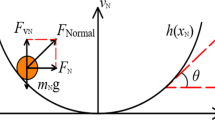Abstract
Many biological attachment devices of insects, spiders and geckos consist of arrays of hairs (setae), which are terminated by contact elements of different shapes. However, the most frequently observed shape is a thin plate-like spatula. In spite of a rather wide range of sizes, most spatulae of different animals are not uniform, but rather possess a gradient in thickness and width. Here we show that the spatulae of insects and geckos become gradually thinner and wider approaching the end. This geometrical effect is explained in the present paper, by using a numerical approach for the modelling of the van der Waals adhesion and friction between the contact elements and the substrate. The approach suggests that the observed negative thickness gradient contributes to the improvement of the adhesion resistance, whereas the positive width gradient increases the stability of the detachment, probably a key factor in controlling the animal walking.
Similar content being viewed by others
References
Aristotle (343 B.C.) Historia animalium, http://etext.virginia.edu/toc/modeng/public/AriHian.html
Arzt E, Gorb S, Spolenak R (2003) From micro to nano contacts in biological attachment devices. Proc Natl Acad Sci USA 100: 10603–10606
Autumn K (2007) Gecko adhesion: structure, function, and applications. MRS Bull 32: 473–478
Autumn K, Dittmore A, Santos D, Spenko M, Cutkosky M. (2006) Frictional adhesion: a new angle on gecko attachment. J Exp Biol 209: 3569–3579
Autumn K, Gravish N (2008) Gecko adhesion: evolutionary nanotechnology. Phil Trans Roy Soc A 366:1575–1590. http://rsta.royalsocietypublishing.org/
Autumn K, Hsieh ST, Dudek DM, Chen J, Chitaphan C, Full JR (2007) Dynamics of geckos running vertically. J Exp Biol 209: 260–272
Autumn K, Liang YA, Hsieh ST, Zesch W, Chan WP, Kenny TW, Fearing R, Full RJ (2000) Adhesive force of a single gecko foot-hair. Nature 405: 681–685
Autumn K, Peattie AM (2002) Mechanisms of adhesion in geckos. Int Comp Biol 42: 1081–1090
Bergmann PJ, Irschick DJ (2005) Effects of temperature on maximum clinging ability in a diurnal gecko: evidence for a passive clinging mechanism?. J Exp Zool 303A: 785–791
Boettger J (1997) All-electron full-potential calculation of the electronic band structure, elastic constants, and equation of state for graphite. Phys Rev B 55(17): 11202–11211
Dellit WD (1934) Zur anatomie und physiologie der geckozehe. Z Naturwiss 68: 613–656
Gao H, Wang X, Yao H, Gorb S, Arzt E (2005) Mechanics of hierarchical adhesion structures of geckos. Mech Mater 37: 275–285
Gennaro JGJ (1969) The gecko grip. Nat Hist 78: 36–43
Girifalco LA, Hodak M, Lee RS (2000) Carbon nanotubes, buckyballs, ropes, and a universal graphitic potential. Phys Rev B 62(19):13104–13110. http://prb.aps.org/
Girifalco LA, Lad RA (1956) Energy of cohesion, compressibility, and the potential energy functions of graphite system. J Chem Phys 25(4):693–697. http://jcp.aip.org/
Gorb SN (2001) Attachment devices of insect cuticle. Kluwer Academic, Dordrecht
Haeshin L, Bruce PL, Phillip BM (2007) A reversible wet/dry adhesive inspired by mussels and geckos. Nature 448: 338–341
Hanfland M, Beister H, Syassen K (1989) Graphite under pressure: equation of state and first-order Raman modes. Phys Rev B 39(17): 12598–12603
Hiller U (1968) Untersuchungen zum feinbau und zur funktion der haftborsten von reptilien. Z Morphol Tiere 62: 307–362
Huber G, Gorb SN, Spolenak R, Arzt E (2005a) Resolving the nanoscale adhesion of individual gecko spatulae by atomic force microscopy. Biol Lett 1: 2–4
Huber G, Mantz H, Spolenak R, Mecke K, Jacobs K, Gorb SN, Arzt E (2005b) Evidence for capillarity contributions to gecko adhesion from single spatula nanomechanical measurements. Proc Natl Acad Sci USA 102: 16293–16296
Kendall K (1975) Thin-film peeling-the elastic term. J Phys D Appl Phys 8:1449–1452. http://iopscience.iop.org/0022-3727
Pugno NM (2007) Towards a spiderman suit: large invisible cables and self-cleaning releasable super-adhesive materials. J Phys: Condens Matter 19: 395001
Pugno NM (2008) Spiderman gloves. Nano Today 3: 36–42
Pugno N, Lepore E (2008) Observation of optimal gecko’s adhesion on nanorough surfaces. Biosystems 94: 218–222
Pugno N, Lepore E (2008) Living tokay geckos display adhesion times following the Weibull statistics. J Adhesion 84: 949–962
Qian D, Liu WK, Ruoff RS (2001) Mechanics of C60 in nanotubes. J Phys Chem B 105: 10753–10758
Ruoff RS, Ruoff AL (1991) The bulk modulus of Ceo molecules and crystals: a molecular mechanical approach. Appl Phys Lett 59(13): 1553–1555
Russell AP (1975) A contribution to the functional analysis of the foot of the Tokay, Gekko gecko (Reptilia: Gekkonidae). J Zool Lond 176: 437–476
Russell AP (1986) The morphological basis of weight-bearing in the scansors of the tokay gecko (Repitilia: Sautia). Can J Zool 64: 948–955
Ruibal R, Ernst V (1965) The structure of the digital setae of lizards. J Morphol 117:271–294. http://onlinelbrary.wiley.com/journal/10.1002/(ISSN)1097-4687
Schleich HH, Kästle W (1986) Ultrastrukturen an gecko-zehen (Reptilia: Sauria: Gekkonidae). Amphib Reptil 7: 141–166
Schmidt HR (1904) Zur anatomie und physiologie der geckopfote. Z Naturwiss 39: 551–563
Simmermacher G (1884) Untersuchungen über haftapparate an tarsalgliedern von insekten . Zeitschr Wiss Zool 40: 481–556
Spurr AR (1969) A low-viscosity epoxy resin embedding medium for electron microscopy. J Ultrastruct Res 26: 31–43
Stork NE (1980) Experimental analysis of adhesion of Chrysopolina polita (Chrysomelidae: Coleoptera) on a variety of surfaces. J Exp Biol 88: 91–107
Yurdumakan B, Raravikar NR, Ajayanm PM, Dhinojwala A (2005) Synthetic gecko foot-hairs from multiwalled carbon nanotubes. Chem Commun 30: 3799–3801
Zhao YX, Spain IL (1989) X-ray diffraction data for graphite to 20 GPa. Phys Rev B 40(2):993–997. http://prb.aps.org/
Author information
Authors and Affiliations
Corresponding author
Rights and permissions
About this article
Cite this article
Pantano, A., Pugno, N.M. & Gorb, S.N. Numerical simulations demonstrate that the double tapering of the spatualae of lizards and insects maximize both detachment resistance and stability. Int J Fract 171, 169–175 (2011). https://doi.org/10.1007/s10704-011-9596-8
Received:
Accepted:
Published:
Issue Date:
DOI: https://doi.org/10.1007/s10704-011-9596-8




